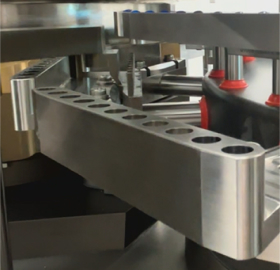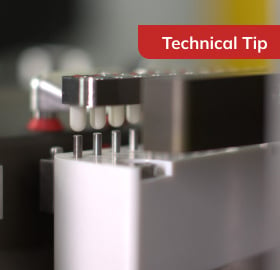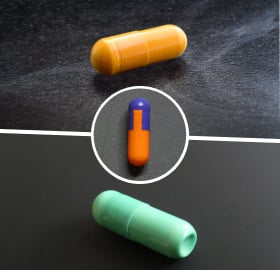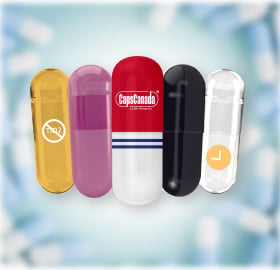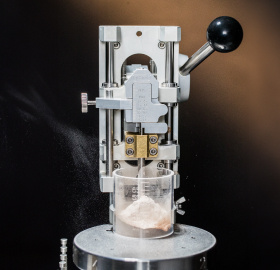Whether they are made of gelatin or HPMC, high-quality capsules will withstand the rigors of many manufacturing and formulation challenges. That said, capsules are not indestructible. To maintain their quality and shelf life, both temperature control and humidity control are vitally important.
Here’s what you need to know…
Proper conditions for capsule storage
Gelatin capsules contain more moisture than HPMC capsules and also tend to lose that moisture more quickly. Empty gelatin capsules have a moisture content between 13% and 16%; empty HPMC capsules have a moisture content between 3% and 8%.
Something to be aware of is that ambient conditions have an outsize impact on empty capsules, as their moisture content will gradually reach equilibrium with the surrounding relative humidity level. If controls are not in place at every point in the production process—including warehouse, storage, transportation, filling and packaging—they can easily either dry out or become too moist.
The conditions required to maintain the capsule’s moisture content within the desired range are:
|
Type of Capsule |
Relative Humidity |
Temperature – Celsius |
Temperature - Fahrenheit |
|
Gelatin capsules |
35% to 65% |
15° to 25° |
59° to 77° |
|
HPMC capsules |
35% to 70% |
15° to 30° |
59° to 86° |
As part of your moisture and humidity control efforts, capsules should always be stored on pallets off the ground and away from hot water or air radiators, hot water pipes, steam pipes and any other source of water condensation (such as under water pipes or in the freezer).
To maintain the correct temperature, avoid storing capsules in direct sunlight, on high rack locations (since heat rises) and near the hot spots that are found near ceiling lights and HVAC vents.
Proper conditions during capsule filling
During cold weather, be aware that heating systems will dry out the air in a facility. In this situation, portable industrial humidifiers can be used to keep the filling room’s relative humidity within the desired range. Otherwise, capsules will quickly lose moisture when they are exposed to the facility’s dry air.
Regardless of the weather, using resealable bag ties for opened capsule cartons is recommended. This makes it easier for operators to protect capsules while in the encapsulation room.
Another often-overlooked issue is the vacuum on the filling machine. Use only as much as necessary to separate the empty capsules, as excessive vacuum can cause pin-hole fracturing in the body dome, which will allow product to leak out of the capsules.
Proper conditions during capsule packaging
During the packaging process, watch out for common heat sources such as blister equipment and heat tunnels. Avoid extended exposure to heat, especially when capsules may sit on hot equipment such as a thermoformer.
For gelatin capsules, which are more vulnerable to water vapor, pay close attention to humidity control in the packaging area, as a small quantity of the surrounding air will be sealed in with the product.
Also, give careful consideration to whether or not to include desiccants (which are designed to absorb moisture) in the packaging. A desiccant can result in overly dry capsules.
Keep learning about capsule technology trends...
- Capsule Storage and Transportation Tips
- What are the differences between Gelantin and HMPC capsules?
- Differences Between HPMC & Pullulan Capsules
Problems seen when climate controls are not in place
Now that we’ve looked at the ideal conditions for capsule storage and handling, let’s consider what can happen when these conditions are not met.
- Brittleness – Too little moisture can cause brittleness, which of course can result in breakage. Gelatin capsules can become brittle when their moisture content falls below 13%. Empty HPMC capsules, which have much less moisture in the first place, are more tolerant of dry conditions. Even so, for those that meet USP dissolution requirements, brittleness can occur when moisture falls below 3%.
- Static build-up – Another problem associated with low relative humidity is the build-up of static electricity in the production area. Whether you are using gelatin capsules or HPMC capsules, this static can cause the empty capsules to stick together, thereby creating capsule flow issues on the filling machine.
- Changes in capsule size – With gelatin capsules, high levels of humidity can cause hydrothermal contraction of the gelatin film, which changes the dimensions of the capsule. This can result in leaking contents, incorrect closure and instability in the fill material.
- Changes in melting point – High humidity levels can also affect gelatin capsules’ melting point, which can impact whether or not the capsule will dissolve as expected after ingestion.
- Cross-linking – For gelatin capsules, cross-linking of the gelatin molecules can occur when the capsules are stored in high temperature and humidity conditions for six months or more. This cross-linking can result in capsules that are practically insoluble.
- Sticky capsules – At high temperatures, capsules will become flaccid and sticky. Groups of capsules will stick to each other, and individual capsules will resist separation.
Conclusion
Need help analyzing your facility to ensure that the proper conditions are in place? This is one of the many services that CapsCanada’s Technical Services team provides for our customers.






